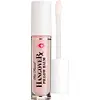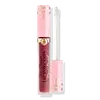Too Faced Hangover Pillow Balm Nourishing Lip Treatment Versus Too Faced Lip Injection Power Plumping Cream Liquid Lipstick
What's inside
What's inside
 Key Ingredients
Key Ingredients

 Benefits
Benefits

 Concerns
Concerns

 Ingredients Side-by-side
Ingredients Side-by-side

Petrolatum
EmollientHydrogenated Polyisobutene
EmollientOctyldodecanol
EmollientBis-Diglyceryl Polyacyladipate-2
EmollientEthylene/Propylene/Styrene Copolymer
Polyethylene
AbrasiveVp/Hexadecene Copolymer
Tocopheryl Acetate
AntioxidantSodium Hyaluronate
HumectantButyrospermum Parkii Butter
Skin ConditioningCocos Nucifera Fruit Juice
EmollientCocos Nucifera Oil
MaskingCucumis Sativus Fruit Extract
EmollientHelianthus Annuus Seedcake
AbrasiveHordeum Vulgare Extract
EmollientMangifera Indica Seed Butter
Skin ConditioningOlea Europaea Fruit Oil
MaskingPersea Gratissima Oil
Skin ConditioningRicinus Communis Seed Oil
MaskingYogurt Powder
Lactobacillus Ferment
Skin ConditioningGlycerin
HumectantPhytosterols
Skin ConditioningMenthol
MaskingPolydecene
Skin ConditioningPropylene Glycol Dicaprate
EmollientC12-15 Alkyl Benzoate
AntimicrobialWater
Skin ConditioningSorbitan Oleate
EmulsifyingMeteorite Powder
Skin ConditioningCholesterol
EmollientButylene/Ethylene/Styrene Copolymer
Silica
AbrasivePolyglyceryl-10 Heptahydroxystearate
Skin ConditioningHydrogenated Castor Oil
EmollientAroma
Saccharin
MaskingBHT
AntioxidantTetrahexyldecyl Ascorbate
AntioxidantPhenoxyethanol
PreservativeMica
Cosmetic ColorantCI 77891
Cosmetic ColorantCI 77491
Cosmetic ColorantCI 77492
Cosmetic ColorantCI 77499
Cosmetic ColorantCI 77163
Cosmetic ColorantCI 42090
Cosmetic ColorantCI 77400
Cosmetic ColorantCI 75470
Cosmetic ColorantCI 15850
Cosmetic ColorantCI 45380
Cosmetic ColorantCI 45410
Cosmetic ColorantCI 73360
Cosmetic ColorantCI 17200
Cosmetic ColorantCI 19140
Cosmetic ColorantCI 15985
Cosmetic ColorantPetrolatum, Hydrogenated Polyisobutene, Octyldodecanol, Bis-Diglyceryl Polyacyladipate-2, Ethylene/Propylene/Styrene Copolymer, Polyethylene, Vp/Hexadecene Copolymer, Tocopheryl Acetate, Sodium Hyaluronate, Butyrospermum Parkii Butter, Cocos Nucifera Fruit Juice, Cocos Nucifera Oil, Cucumis Sativus Fruit Extract, Helianthus Annuus Seedcake, Hordeum Vulgare Extract, Mangifera Indica Seed Butter, Olea Europaea Fruit Oil, Persea Gratissima Oil, Ricinus Communis Seed Oil, Yogurt Powder, Lactobacillus Ferment, Glycerin, Phytosterols, Menthol, Polydecene, Propylene Glycol Dicaprate, C12-15 Alkyl Benzoate, Water, Sorbitan Oleate, Meteorite Powder, Cholesterol, Butylene/Ethylene/Styrene Copolymer, Silica, Polyglyceryl-10 Heptahydroxystearate, Hydrogenated Castor Oil, Aroma, Saccharin, BHT, Tetrahexyldecyl Ascorbate, Phenoxyethanol, Mica, CI 77891, CI 77491, CI 77492, CI 77499, CI 77163, CI 42090, CI 77400, CI 75470, CI 15850, CI 45380, CI 45410, CI 73360, CI 17200, CI 19140, CI 15985
Isododecane
EmollientHydrogenated Polyisobutene
EmollientPolyethylene
AbrasiveDiisostearyl Malate
EmollientDimethicone
EmollientBis-Diglyceryl Polyacyladipate-2
EmollientSynthetic Fluorphlogopite
C18-36 Acid Triglyceride
EmollientDisteardimonium Hectorite
StabilisingDimethicone/Vinyl Dimethicone Crosspolymer
Skin ConditioningSimmondsia Chinensis Seed Oil
EmollientEthylene/Propylene/Styrene Copolymer
Vanillyl Butyl Ether
MaskingPunica Granatum Flower Extract
Skin ConditioningPolyglyceryl-3 Diisostearate
EmulsifyingRosa Canina Fruit Extract
AstringentSilica
AbrasivePropylene Carbonate
SolventButylene/Ethylene/Styrene Copolymer
Parfum
MaskingPentaerythrityl Tetra-Di-T-Butyl Hydroxyhydrocinnamate
AntioxidantBHT
AntioxidantCI 77891
Cosmetic ColorantCI 77491
Cosmetic ColorantCI 77492
Cosmetic ColorantCI 77499
Cosmetic ColorantCI 15850
Cosmetic ColorantCI 45410
Cosmetic ColorantCI 19140
Cosmetic ColorantCI 15985
Cosmetic ColorantIsododecane, Hydrogenated Polyisobutene, Polyethylene, Diisostearyl Malate, Dimethicone, Bis-Diglyceryl Polyacyladipate-2, Synthetic Fluorphlogopite, C18-36 Acid Triglyceride, Disteardimonium Hectorite, Dimethicone/Vinyl Dimethicone Crosspolymer, Simmondsia Chinensis Seed Oil, Ethylene/Propylene/Styrene Copolymer, Vanillyl Butyl Ether, Punica Granatum Flower Extract, Polyglyceryl-3 Diisostearate, Rosa Canina Fruit Extract, Silica, Propylene Carbonate, Butylene/Ethylene/Styrene Copolymer, Parfum, Pentaerythrityl Tetra-Di-T-Butyl Hydroxyhydrocinnamate, BHT, CI 77891, CI 77491, CI 77492, CI 77499, CI 15850, CI 45410, CI 19140, CI 15985
Ingredients Explained
These ingredients are found in both products.
Ingredients higher up in an ingredient list are typically present in a larger amount.
BHT is a synthetic antioxidant and preservative.
As an antioxidant, it helps your body fight off free-radicals. Free-radicals are molecules that may damage your skin cells.
As a preservative, it is used to stabilize products and prevent them from degrading. Specifically, BHT prevents degradation from oxidation.
The concerns related to BHT come from oral studies; this ingredient is currently allowed for use by both the FDA and EU.
However, it was recently restricted for use in the UK as of April 2024.
Learn more about BHTThis ingredient is lipid-based synthetic skin-conditioning agent derived from adipic acid and a mixture of fatty acids. It is often called a lanolin substitute.
As an emollient, it helps soften and hydrate the skin. Emollients create a barrier on the skin to trap moisture in.
Due to its fatty acid base, it may not be Malassezia folliculitis safe.
Learn more about Bis-Diglyceryl Polyacyladipate-2We don't have a description for Butylene/Ethylene/Styrene Copolymer yet.
Ci 15850 is the pigment color red. It is an azo dye and created synthetically.
Azo dyes need to be thoroughly purified before use. This allows them to be more stable and longer-lasting.
This ingredient is common in foundations, lipsticks, and blushes. This color is described as brown/orangey red.
It has many secondary names such as Red 6 and Red 7. According to a manufacturer, Red 6 usually contains aluminum.
Learn more about CI 15850Ci 15985 is a dye made from petroleum. It is synthetically created and approved by the FDA for use in foods and cosmetics.
The color of this dye is orange/yellow.
This ingredient can be found in makeup, sun care, and skincare.
Learn more about CI 15985CI 19140 is also known as Tartrazine. Tartrazine is a synthetic dye used in cosmetics, foods, and medicine to add a yellow color.
Tartrazine is created from petroleum and is water-soluble.
Some people may experience allergies from this dye, especially asthmatics and those with an aspirin intolerance.
Learn more about CI 19140CI 45410 is a synthetic red-pigment and dye.
It often goes by both Red 28 or Red 27; manufacturers label both ingredients as CI 45410.
This dye is commonly found in makeup because it imparts a vivid color. Some types of this dye change color based on pH level and interaction with moisture:
Your skin has a natural pH of around 4.5 - 5.5.
According to the FDA, CI 45410 is not permitted for use in eye products.
Red 27 is a flourescein dye and commonly used as a fluorescent tracer in medicine.
Learn more about CI 45410Ci 77491 is also hydrated iron III oxide. It's sole purpose is to give a red/pink hue to products.
Iron III oxides are classified as inorganic chemicals for coloring.
Synthetically created Ci 77491 is considered safer than those naturally found. This is because the synthetically created version may contain less impurities. Iron oxides are generally non-toxic and non-allergenic.
Learn more about CI 77491Ci 77492 is also hydrated iron III oxide. It's sole purpose is to give a yellow hue to products.
Iron III oxides are classified as inorganic chemicals for coloring.
Synthetically created Ci 77492 is considered safer than those naturally found. This is because the synthetically created version may contain less impurities. Iron oxides are generally non-toxic and non-allergenic.
Learn more about CI 77492Ci 77499 is also hydrated iron III oxide. It is created from mixing red and black iron oxides. This helps give shades of darkness to a product.
Iron III oxides are classified as inorganic chemicals for coloring.
Ci 77891 is a white pigment from Titanium dioxide. It is naturally found in minerals such as rutile and ilmenite.
It's main function is to add a white color to cosmetics. It can also be mixed with other colors to create different shades.
Ci 77891 is commonly found in sunscreens due to its ability to block UV rays.
Learn more about CI 77891We don't have a description for Ethylene/Propylene/Styrene Copolymer yet.
Hydrogenated Polyisobutene is a synthetic polymer. Polymers are compounds with high molecular weight. Hydrogenated Polyisobutene is an emollient and texture enhancer.
In one study, Hydrogenated Polyisobutene showed better skin hydration levels than Caprylic/Capric Triglyceride. As an emollient, it helps keep your skin soft and hydrated by trapping moisture in.
Hydrogenated Polyisobutene is often used as a mineral oil replacement.
Learn more about Hydrogenated PolyisobutenePolyethylene is a synthetic ingredient that helps the skin retain moisture. It is a polymer.
It is also typically used within product formulations to help bind solid ingredients together and thicken oil-based ingredients. When added to balms and emulsions, it helps increase the melting point temperature.
Silica, also known as silicon dioxide, is a naturally occurring mineral. It is used as a fine, spherical, and porous powder in cosmetics.
Though it has exfoliant properties, the function of silica varies depending on the product.
The unique structure of silica enhances the spreadability and adds smoothness, making it a great texture enhancer.
It is also used as an active carrier, emulsifier, and mattifier due to its ability to absorb excess oil.
In some products, tiny microneedles called spicules are made from silica or hydrolyzed sponge. When you rub them in, they lightly polish away dead skin layers and enhance the penetration of active ingredients.
Learn more about Silica